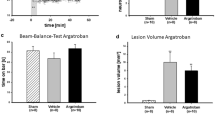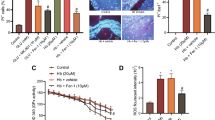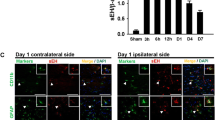Abstract
Little is known about the pathophysiology of oral anticoagulation-associated intracerebral hemorrhage (OAC-ICH). We compared hematoma volume, number of terminal deoxynucleotidyl dUTP nick-end labeling (TUNEL)-positive cells (indicating cell death), MMP-9 levels, and perilesional edema formation between warfarin-treated mice and controls. Intracerebral hemorrhage was induced by an injection of collagenase into the right striatum. Twenty-four hours later, hematoma volume was measured using a photometric hemoglobin assay. Cell death was quantified using TUNEL staining. MMP-9 levels were determined by zymography, and edema formation was assessed via the wet–dry method. Warfarin increased hematoma volume by 2.6-fold. The absolute number of TUNEL-positive cells in the perihematomal zone was lower in warfarin-treated animals (300.5 ± 39.8 cells/mm2) than in controls (430.5 ± 38.9 cells/mm2; p = 0.034), despite the larger bleeding volume. MMP-9 levels were reduced in anticoagulated mice as compared to controls (p = 0.018). Perilesional edema formation was absent in warfarin mice and modestly present in controls. Our results suggest differences in the pathophysiology of OAC-ICH compared to intracerebral hemorrhage occurring under normal coagulation. A likely explanation is that thrombin, a strong inductor of apoptotic cell death and blood–brain barrier disruption, is produced to a lesser extent in OAC-ICH. In humans, however, we assume that the detrimental effects of a larger hematoma volume in OAC-ICH by far outweigh potential protective effects of thrombin deficiency.





Similar content being viewed by others
References
Steiner T, Rosand J, Diringer M. Intracerebral hemorrhage associated with oral anticoagulant therapy: current practices and unresolved questions. Stroke. 2006;37:256–62.
Sjalander A, Engstrom G, Berntorp E, Svensson P. Risk of haemorrhagic stroke in patients with oral anticoagulation compared with the general population. J Intern Med. 2003;254:434–8.
Rosand J, Eckman MH, Knudsen KA, Singer DE, Greenberg SM. The effect of warfarin and intensity of anticoagulation on outcome of intracerebral hemorrhage. Arch Intern Med. 2004;164:880–4.
Flaherty ML, Tao H, Haverbusch M, et al. Warfarin use leads to larger intracerebral hematomas. Neurology. 2008;71:1084–9.
Flaherty ML, Haverbusch M, Sekar P, et al. Location and outcome of anticoagulant-associated intracerebral hemorrhage. Neurocrit Care. 2006;5:197–201.
Flibotte JJ, Hagan N, O’Donnell J, Greenberg SM, Rosand J. Warfarin, hematoma expansion, and outcome of intracerebral hemorrhage. Neurology. 2004;63:1059–64.
Levine JM, Snider R, Finkelstein D, et al. Early edema in warfarin-related intracerebral hemorrhage. Neurocrit Care. 2007;7:58–63.
Xi G, Keep RF, Hoff JT. Mechanisms of brain injury after intracerebral haemorrhage. Lancet Neurol. 2006;5:53–63.
Hua Y, Keep RF, Hoff JT, Xi G. Brain injury after intracerebral hemorrhage: the role of thrombin and iron. Stroke. 2007;38:759–62.
Donovan FM, Pike CJ, Cotman CW, Cunningham DD. Thrombin induces apoptosis in cultured neurons and astrocytes via a pathway requiring tyrosine kinase and RhoA activities. J Neurosci. 1997;17:5316–26.
Foerch C, Arai K, Jin G, et al. Experimental model of warfarin-associated intracerebral hemorrhage. Stroke. 2008;39:3397–404.
Xue M, Del Bigio MR. Acute tissue damage after injections of thrombin and plasmin into rat striatum. Stroke. 2001;32:2164–9.
Wang J, Tsirka SE. Neuroprotection by inhibition of matrix metalloproteinases in a mouse model of intracerebral haemorrhage. Brain. 2005;128:1622–33.
Illanes S, Zhou W, Schwarting S, Heiland S, Veltkamp R. Comparative effectiveness of hemostatic therapy in experimental warfarin-associated intracerebral hemorrhage. Stroke. 2011;42:191–5.
Schlunk F, Van Cott EM, Hayakawa K, Pfeilschifter W, Lo EH, Foerch C. Recombinant activated coagulation factor VII and prothrombin complex concentrates are equally effective in reducing hematoma volume in experimental warfarin-associated intracerebral hemorrhage. Stroke. 2012;43:246–9.
Illanes S, Zhou W, Heiland S, Markus Z, Veltkamp R. Kinetics of hematoma expansion in murine warfarin-associated intracerebral hemorrhage. Brain Res. 2010;1320:135–42.
Foerch C, Arai K, Van Cott EM, van Leyen K, Lo EH. Rapid reversal of anticoagulation reduces hemorrhage volume in a mouse model of warfarin-associated intracerebral hemorrhage. J Cereb Blood Flow Metab. 2009;29:1015–21.
Xue M, Del Bigio MR. Injections of blood, thrombin, and plasminogen more severely damage neonatal mouse brain than mature mouse brain. Brain Pathol. 2005;15:273–80.
Lee KR, Kawai N, Kim S, Sagher O, Hoff JT. Mechanisms of edema formation after intracerebral hemorrhage: effects of thrombin on cerebral blood flow, blood-brain barrier permeability, and cell survival in a rat model. J Neurosurg. 1997;86:272–8.
Xi G, Reiser G, Keep RF. The role of thrombin and thrombin receptors in ischemic, hemorrhagic and traumatic brain injury: deleterious or protective. J Neurochem. 2003;84:3–9.
Kawakita K, Kawai N, Kuroda Y, Yasashita S, Nagao S. Expression of matrix metalloproteinase-9 in thrombin-induced brain edema formation in rats. J Stroke Cerebrovasc Dis. 2006;15:88–95.
Xue M, Hollenberg MD, Yong VW. Combination of thrombin and matrix metalloproteinase-9 exacerbates neurotoxicity in cell culture and intracerebral hemorrhage in mice. J Neurosci. 2006;26:10281–91.
Thirumangalakudi L, Rao HV, Grammas P. Involvement of PGE2 and PGDH but not COX- 2 in thrombin-induced cortical neuron apoptosis. Neurosci Lett. 2009;452:172–5.
Rao HV, Thirumangalakudi L, Desmond P, Grammas P. Cyclin D1, cdk4, and Bim are involved in thrombin-induced apoptosis in cultured cortical neurons. J Neurochem. 2007;101:498–505.
Rosell A, Ortega-Aznar A, Alvarez-Sabin J, et al. Increased brain expression of matrix metalloproteinase-9 after ischemic and hemorrhagic human stroke. Stroke. 2006;37:1399–406.
Wu H, Zhang Z, Li Y, et al. Time course of upregulation of inflammatory mediators in the hemorrhagic brain in rats: correlation with brain edema. Neurochem Int. 2010;57:248–53.
Ichikawa K, Yanagihara C. Sedimentation level in acute intracerebral hematoma in a patient receiving anticoagulation therapy: an autopsy study. Neuroradiology. 1998;40:380–2.
Gulati G, Hevelow M, George M, Behling E, Siegel J. International normalized ratio versus plasma levels of coagulation factors in patients on vitamin K antagonist therapy. Arch Pathol Lab Med. 2011;135:490–4.
Acknowledgments
None.
Conflict of Interest
The authors declare that they have no conflict of interest.
Author information
Authors and Affiliations
Corresponding author
Rights and permissions
About this article
Cite this article
Schlunk, F., Schulz, E., Lauer, A. et al. Warfarin Pretreatment Reduces Cell Death and MMP-9 Activity in Experimental Intracerebral Hemorrhage. Transl. Stroke Res. 6, 133–139 (2015). https://doi.org/10.1007/s12975-014-0377-3
Received:
Revised:
Accepted:
Published:
Issue Date:
DOI: https://doi.org/10.1007/s12975-014-0377-3




